1st Edition Philosophy CLASSICS: My Day with the "Nietzsche Guy"
I recently had the privilege and pleasure to visit a local rare books dealer dubbed "The Nietzsche Guy", more formally known as Athena Rare Books (and more informally as Bill). To my delight, he traffics exclusively in first-edition philosophy classics! Suffice it to say I was fanboying pretty hard.
I uploaded a collection of pictures from my first visit to my Instagram account which goes by the same name, distillationsbl if you're interested in following me there, no pressure, not like it would make my day or anything... (I guess if I'm already at it, here's my shameless Twitter plug).
Here on Steemit I have the opportunity to expand a bit and provide some links for anyone who wants to dig a little deeper! So that's the plan for this post, and I'm hoping to have Bill on the Casually Curious podcast to chat about Nietzsche, how he got into the rare books business, and any other casual curiosities that come to mind. We were able to chat it up during this first visit and he is quite the erudite fellow--I guarantee your satisfaction for that episode (disregarding curmudgeons... don't sue me).
Without further ado, my visit to Athena Rare Books! You can find the catalogs these pictures are featured in here ('17), here ('16), and here ('15). It's an enormously impressive collection. My jaw was unhinged for the entirety of the visit.
Immanuel Kant's "The Critique of Pure Reason"

Immanuel Kant (1724 -- 1804)
The following are excerpts on Kant from the invaluable Stanford Encyclopedia of Philosophy, the best starting-point for any philosophical research.
- Intro
Immanuel Kant (1724–1804) is the central figure in modern philosophy. He synthesized early modern rationalism and empiricism, set the terms for much of nineteenth and twentieth century philosophy, and continues to exercise a significant influence today in metaphysics, epistemology, ethics, political philosophy, aesthetics, and other fields. The fundamental idea of Kant's “critical philosophy” — especially in his three Critiques: the Critique of Pure Reason (1781, 1787), the Critique of Practical Reason (1788), and the Critique of the Power of Judgment (1790) — is human autonomy. He argues that the human understanding is the source of the general laws of nature that structure all our experience; and that human reason gives itself the moral law, which is our basis for belief in God, freedom, and immortality. Therefore, scientific knowledge, morality, and religious belief are mutually consistent and secure because they all rest on the same foundation of human autonomy, which is also the final end of nature according to the teleological worldview of reflecting judgment that Kant introduces to unify the theoretical and practical parts of his philosophical system.
- Enigmatic Ideas
The main topic of the Critique of Pure Reason is the possibility of metaphysics, understood in a specific way. Kant defines metaphysics in terms of “the cognitions after which reason might strive independently of all experience,” and his goal in the book is to reach a “decision about the possibility or impossibility of a metaphysics in general, and the determination of its sources, as well as its extent and boundaries, all, however, from principles” (Axii. See also Bxiv; and 4:255–257). Thus metaphysics for Kant concerns a priori knowledge, or knowledge whose justification does not depend on experience; and he associates a priori knowledge with reason. The project of the Critique is to examine whether, how, and to what extent human reason is capable of a priori knowledge.
From Athena's catalog:
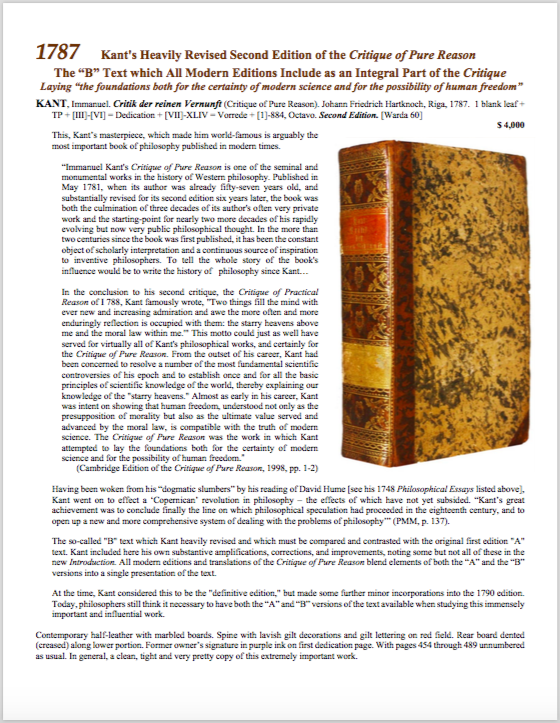
- Book Details
This, Kant’s masterpiece, which made him world-famous is arguably the most important book of philosophy published in modern times.
In the conclusion to his second critique, the Critique of Practical Reason of I 788, Kant famously wrote, "Two things fill the mind with ever new and increasing admiration and awe the more often and more enduringly reflection is occupied with them: the starry heavens above me and the moral law within me.'" This motto could just as well have served for virtually all of Kant's philosophical works, and certainly for the Critique of Pure Reason. From the outset of his career, Kant had been concerned to resolve a number of the most fundamental scientific controversies of his epoch and to establish once and for all the basic principles of scientific knowledge of the world, thereby explaining our knowledge of the "starry heavens." Almost as early in his career, Kant was intent on showing that human freedom, understood not only as the presupposition of morality but also as the ultimate value served and advanced by the moral law, is compatible with the truth of modern science. The Critique of Pure Reason was the work in which Kant attempted to lay the foundations both for the certainty of modern science and for the possibility of human freedom.”
(Cambridge Edition of the Critique of Pure Reason, 1998, pp. 1-2)
Contemporary half-leather with marbled boards. Spine with lavish gilt decorations and gilt lettering on red field. Rear board dented (creased) along lower portion. Former owner’s signature in purple ink on first dedication page. With pages 454 through 489 unnumbered as usual. In general, a clean, tight and very pretty copy of this extremely important work.
Plato's "The Complete Works of Plato" (The Stephanus Edition)
'The Book That Established the UNIVERSAL REFERENCE System for Plato's Writings'
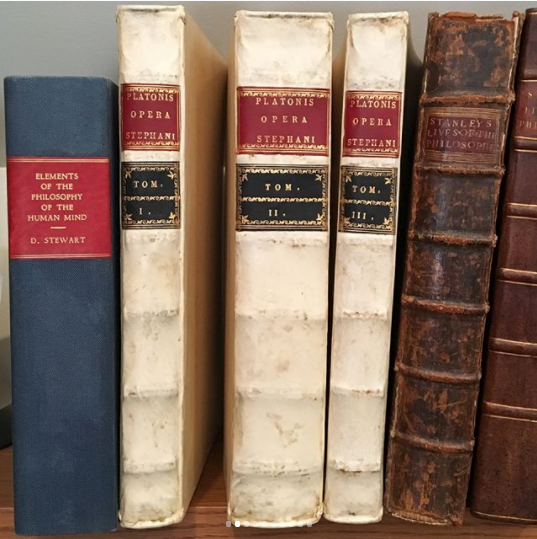
Plato (~429 -- 247 B.C.E.)
From Stanford Encyclopedia of Philosophy's entry on Plato:
- Intro
Plato (429?–347 B.C.E.) is, by any reckoning, one of the most dazzling writers in the Western literary tradition and one of the most penetrating, wide-ranging, and influential authors in the history of philosophy. An Athenian citizen of high status, he displays in his works his absorption in the political events and intellectual movements of his time, but the questions he raises are so profound and the strategies he uses for tackling them so richly suggestive and provocative that educated readers of nearly every period have in some way been influenced by him, and in practically every age there have been philosophers who count themselves Platonists in some important respects. He was not the first thinker or writer to whom the word “philosopher” should be applied. But he was so self-conscious about how philosophy should be conceived, and what its scope and ambitions properly are, and he so transformed the intellectual currents with which he grappled, that the subject of philosophy, as it is often conceived—a rigorous and systematic examination of ethical, political, metaphysical, and epistemological issues, armed with a distinctive method—can be called his invention. Few other authors in the history of Western philosophy approximate him in depth and range: perhaps only Aristotle (who studied with him), Aquinas, and Kant would be generally agreed to be of the same rank.
- Enigmatic Ideas
The world that appears to our senses is in some way defective and filled with error, but there is a more real and perfect realm, populated by entities (called “forms” or “ideas”) that are eternal, changeless, and in some sense paradigmatic for the structure and character of the world presented to our senses.
From Athena's catalog:

- Book Details
This Stephanus edition, however, is deserving of special attention because it has served ever since its publication as the universal reference system for all other editions of Plato and still provides today the basis of the universally accepted way of quoting from Plato.
All three volumes bound in 20th century full vellum. The spines with six raised bands and a title piece with gilt lettering on a red field for author and title in the second compartment and gilt lettering on a black field in the third compartment indicating the volume number. Large, dated, woodcut device of St. Paul and the olive tree on TP of the first volume, numerous woodcut head- and tailpieces and ornamental initials, text in two columns, in Greek and Latin. The title pages of Volumes 1 and 2 each have a 1⁄2” deep circular ink scribble running across the very top of the page obliterating some earlier inscription. The first volume also has a five line contemporary inscription in the free space to the bottom right of the St. Paul device. Overall, a lovely set which is more commonly seen bound as two volumes (i.e. volumes 1 & 3 bound together and volume 2 separate).
Isaac Newton's "Mathematical Principles of Natural Philosophy" (Principia Mathematica)
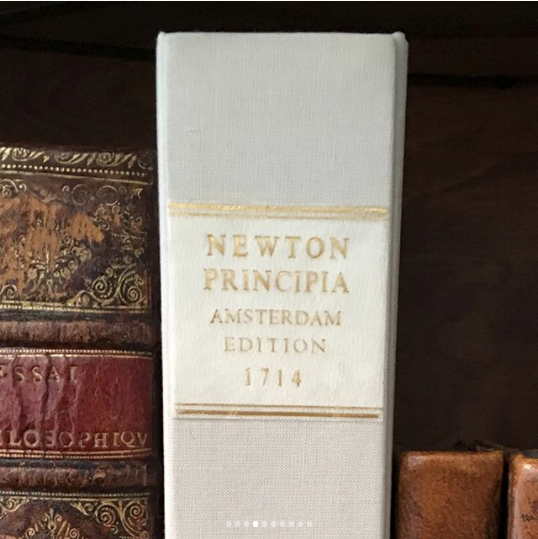
Isaac Newton (1642 -- 1727)
From Stanford Encyclopedia of Philosophy's entry on Newton:
- Intro
Isaac Newton (1642–1727) is best known for having invented the calculus in the mid to late 1660s (most of a decade before Leibniz did so independently, and ultimately more influentially) and for having formulated the theory of universal gravity — the latter in his Principia, the single most important work in the transformation of early modern natural philosophy into modern physical science. Yet he also made major discoveries in optics beginning in the mid-1660s and reaching across four decades; and during the course of his 60 years of intense intellectual activity he put no less effort into chemical and alchemical research and into theology and biblical studies than he put into mathematics and physics. He became a dominant figure in Britain almost immediately following publication of his Principia in 1687, with the consequence that “Newtonianism” of one form or another had become firmly rooted there within the first decade of the eighteenth century. His influence on the continent, however, was delayed by the strong opposition to his theory of gravity expressed by such leading figures as Christiaan Huygens and Leibniz, both of whom saw the theory as invoking an occult power of action at a distance in the absence of Newton's having proposed a contact mechanism by means of which forces of gravity could act. As the promise of the theory of gravity became increasingly substantiated, starting in the late 1730s but especially during the 1740s and 1750s, Newton became an equally dominant figure on the continent, and “Newtonianism,” though perhaps in more guarded forms, flourished there as well. What physics textbooks now refer to as “Newtonian mechanics” and “Newtonian science” consists mostly of results achieved on the continent between 1740 and 1800.
- Enigmatic Ideas
Biographers and analysts who try to piece together a unified picture of Newton and his intellectual endeavors often end up telling us almost as much about themselves as about Newton.
Compounding the diversity of the subjects to which Newton devoted time are sharp contrasts in his work within each subject. Optics and orbital mechanics both fall under what we now call physics, and even then they were seen as tied to one another, as indicated by Descartes' first work on the subject, Le Monde, ou Traité de la lumierè. Nevertheless, two very different “Newtonian” traditions in physics arose from Newton's Opticks and Principia: from his Opticks a tradition centered on meticulous experimentation and from his Principia a tradition centered on mathematical theory. The most important element common to these two was Newton's deep commitment to having the empirical world serve not only as the ultimate arbiter, but also as the sole basis for adopting provisional theory. Throughout all of this work he displayed distrust of what was then known as the method of hypotheses – putting forward hypotheses that reach beyond all known phenomena and then testing them by deducing observable conclusions from them. Newton insisted instead on having specific phenomena decide each element of theory, with the goal of limiting the provisional aspect of theory as much as possible to the step of inductively generalizing from the specific phenomena.
From Athena's catalog:
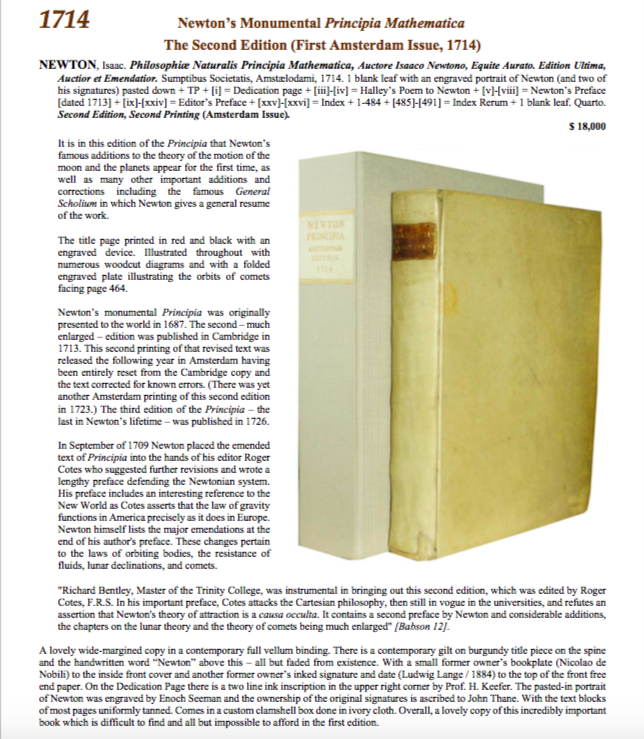
- Book Details
A lovely wide-margined copy in a contemporary full vellum binding. There is a contemporary gilt on burgundy title piece on the spine and the handwritten word “Newton” above this – all but faded from existence. With a small former owner’s bookplate (Nicolao de Nobili) to the inside front cover and another former owner’s inked signature and date (Ludwig Lange / 1884) to the top of the front free end paper. On the Dedication Page there is a two line ink inscription in the upper right corner by Prof. H. Keefer. The pasted-in portrait of Newton was engraved by Enoch Seeman and the ownership of the original signatures is ascribed to John Thane. With the text blocks of most pages uniformly tanned. Comes in a custom clamshell box done in ivory cloth. Overall, a lovely copy of this incredibly important book which is difficult to find and all but impossible to afford in the first edition.
G. W. F. Hegel's "Science of Logic"
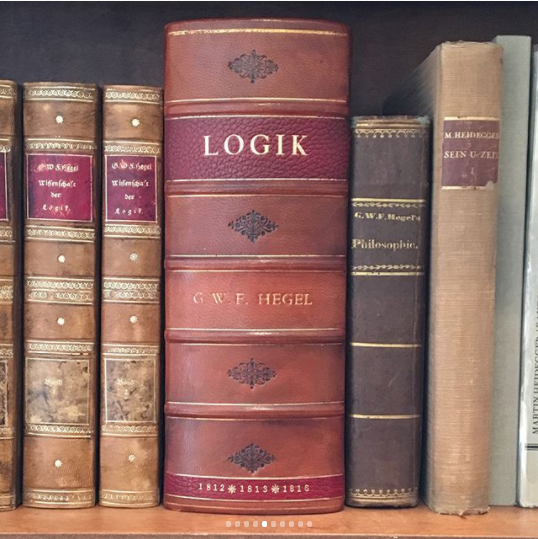
Georg Wilhelm Friedrich Hegel (1770 -- 1831)
From Stanford Encyclopedia of Philosophy's entry on Hegel:
- Intro
Along with J.G. Fichte and, at least in his early work, F.W.J. von Schelling, Hegel (1770–1831) belongs to the period of German idealism in the decades following Kant. The most systematic of the post-Kantian idealists, Hegel attempted, throughout his published writings as well as in his lectures, to elaborate a comprehensive and systematic philosophy from a purportedly logical starting point. He is perhaps most well-known for his teleological account of history, an account that was later taken over by Marx and “inverted” into a materialist theory of an historical development culminating in communism. While idealist philosophies in Germany post-dated Hegel (Beiser 2014), the movement commonly known as German idealism effectively ended with Hegel’s death. Certainly since the revolutions in logical thought from the turn of the twentieth century, the logical side of Hegel’s thought has been largely forgotten, although his political and social philosophy and theological views have continued to find interest and support. Since the 1970s, however, a degree of more general philosophical interest in Hegel’s systematic thought has been revived.
- Enigmatic Ideas
Given the understanding of Hegel that predominated at the time of the birth of analytic philosophy, together with the fact that early analytic philosophers were rebelling precisely against Hegelianism so understood, the interpretation of Hegel encountered in discussions within analytic philosophy is often that of the late nineteenth-century interpretation. In this picture, Hegel is seen as offering a metaphysico-religious view of God qua Absolute Spirit, as the ultimate reality that we can come to know through pure thought processes alone. In short, Hegel’s philosophy is treated as exemplifying the type of pre-critical or dogmatic metaphysics against which Kant had reacted in his Critique of Pure Reason, and as a return to a more religiously driven conception of philosophy to which Kant had been opposed.
From Athena's catalog:
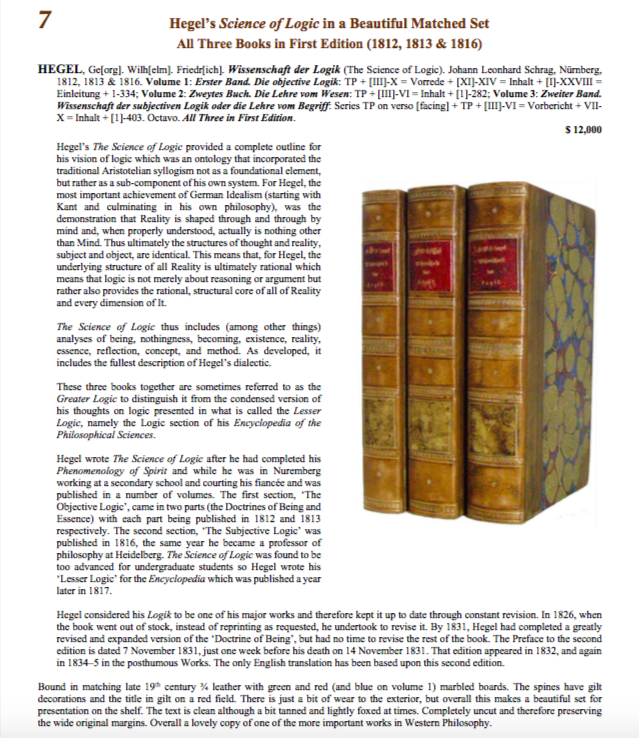
- Book Details
Bound in matching late 19th century 3⁄4 leather with green and red (and blue on volume 1) marbled boards. The spines have gilt decorations and the title in gilt on a red field. There is just a bit of wear to the exterior, but overall this makes a beautiful set for presentation on the shelf. The text is clean although a bit tanned and lightly foxed at times. Completely uncut and therefore preserving the wide original margins. Overall a lovely copy of one of the more important works in Western Philosophy.
Friedrich Nietzsche's "Thus Spake Zarathustra" (Henry & Co. Printing)
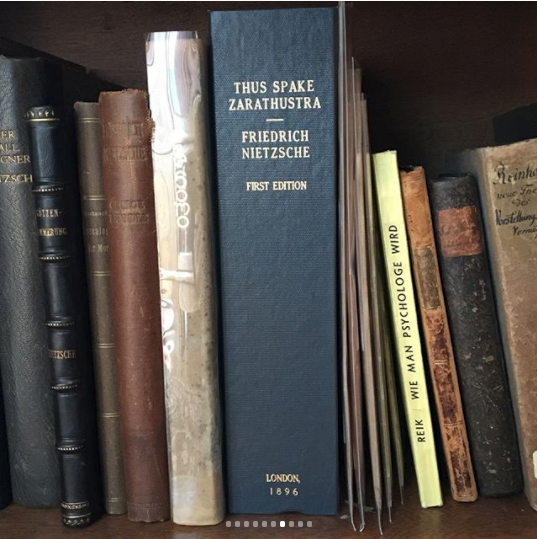
Friedrich Nietzsche (1844 -- 1900)
From Stanford Encyclopedia of Philosophy's entry on Nietzsche:
- Intro
Friedrich Nietzsche (1844–1900) was a German philosopher and cultural critic who published intensively in the 1870s and 1880s. He is famous for uncompromising criticisms of traditional European morality and religion, as well as of conventional philosophical ideas and social and political pieties associated with modernity. Many of these criticisms rely on psychological diagnoses that expose false consciousness infecting people’s received ideas; for that reason, he is often associated with a group of late modern thinkers (including Marx and Freud) who advanced a “hermeneutics of suspicion” against traditional values (see Foucault [1964] 1990, Ricoeur [1965] 1970, Leiter 2004). Nietzsche also used his psychological analyses to support original theories about the nature of the self and provocative proposals suggesting new values that he thought would promote cultural renewal and improve social and psychological life by comparison to life under the traditional values he criticized.
- Enigmatic Ideas
Nietzsche’s appeals to the notion of perspective (or, equivalently in his usage, to an “optics” of knowledge) have a positive, as well as a critical side. Nietzsche frequently criticizes “dogmatic” philosophers for ignoring the perspectival limitations on their theorizing, but as we saw, he simultaneously holds that the operation of perspective makes a positive contribution to our cognitive endeavors: speaking of (what he takes to be) the perversely counterintuitive doctrines of some past philosophers, he writes,
"Particularly as knowers, let us not be ungrateful toward such resolute reversals of the familiar perspectives and valuations with which the spirit has raged against itself all too long… : to see differently in this way for once, to want to see differently, is no small discipline and preparation of the intellect for its future 'objectivity'—the latter understood not as 'disinterested contemplation' (which is a non-concept and absurdity), but rather as the capacity to have one’s Pro and Contra in one’s power, and to shift them in and out, so that one knows how to make precisely the difference in perspectives and affective interpretations useful for knowledge." (GM III, 12)
From Athena's catalog:
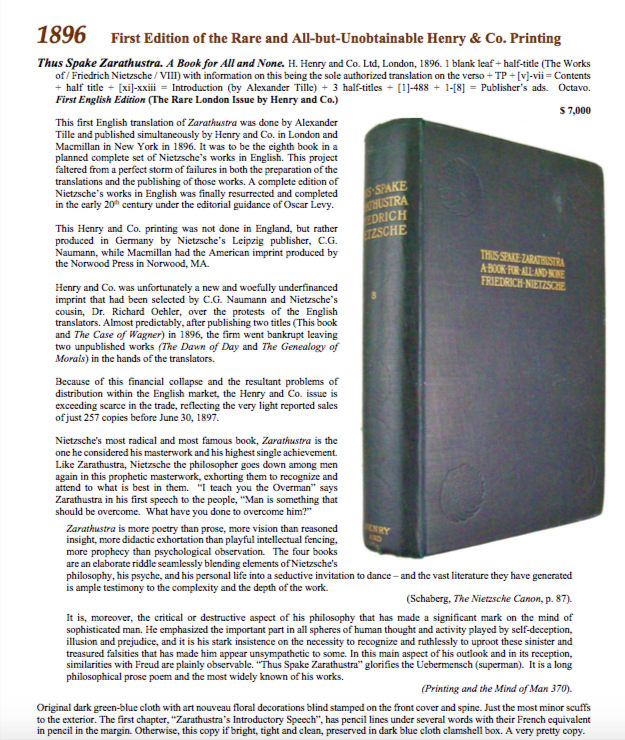
- Book Details
Original dark green-blue cloth with art nouveau floral decorations blind stamped on the front cover and spine. Just the most minor scuffs to the exterior. The first chapter, “Zarathustra’s Introductory Speech”, has pencil lines under several words with their French equivalent in pencil in the margin. Otherwise, this copy if bright, tight and clean, preserved in dark blue cloth clamshell box. A very pretty copy.
Ludwig Wittgenstein's "Philosophical Investigations"
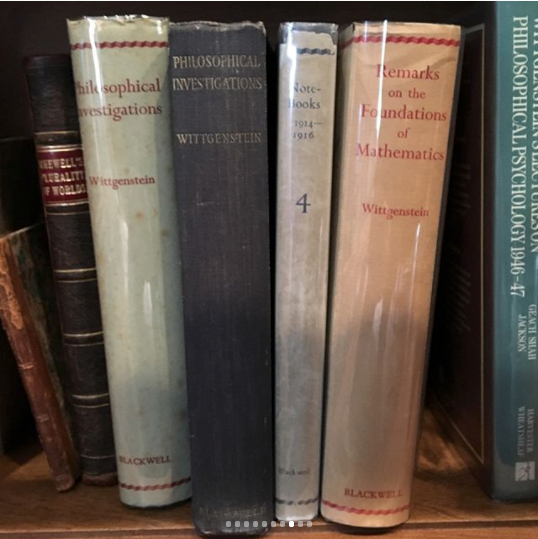
Ludwig Wittgenstein (1889 -- 1951)
From Stanford Encyclopedia of Philosophy's entry on Wittgenstein:
- Intro
Considered by some to be the greatest philosopher of the 20th century, Ludwig Wittgenstein played a central, if controversial, role in 20th-century analytic philosophy. He continues to influence current philosophical thought in topics as diverse as logic and language, perception and intention, ethics and religion, aesthetics and culture. Originally, there were two commonly recognized stages of Wittgenstein’s thought—the early and the later—both of which were taken to be pivotal in their respective periods. In more recent scholarship, this division has been questioned: some interpreters have claimed a unity between all stages of his thought, while others talk of a more nuanced division, adding stages such as the middle Wittgenstein and the third Wittgenstein. Still, it is commonly acknowledged that the early Wittgenstein is epitomized in his Tractatus Logico-Philosophicus. By showing the application of modern logic to metaphysics, via language, he provided new insights into the relations between world, thought and language and thereby into the nature of philosophy. It is the later Wittgenstein, mostly recognized in the Philosophical Investigations, who took the more revolutionary step in critiquing all of traditional philosophy including its climax in his own early work. The nature of his new philosophy is heralded as anti-systematic through and through, yet still conducive to genuine philosophical understanding of traditional problems.
- Enigmatic Ideas
In the Preface to PI, Wittgenstein states that his new thoughts would be better understood by contrast with and against the background of his old thoughts, those in the Tractatus; and indeed, most of Part I of PI is essentially critical. Its new insights can be understood as primarily exposing fallacies in the traditional way of thinking about language, truth, thought, intentionality, and, perhaps mainly, philosophy. In this sense, it is conceived of as a therapeutic work, viewing philosophy itself as therapy. (Part II (PPF), focusing on philosophical psychology, perception etc., was not as critical. Rather, it pointed to new perspectives (which, undoubtedly, are not disconnected from the earlier critique) in addressing specific philosophical issues. It is, therefore, more easily read alongside Wittgenstein’s other writings of the later period.)
PI begins with a quote from Augustine’s Confessions which “give us a particular picture of the essence of human language,” based on the idea that “the words in language name objects,” and that “sentences are combinations of such names” (PI 1). This picture of language cannot be relied on as a basis for metaphysical, epistemic or linguistic speculation. Despite its plausibility, this reduction of language to representation cannot do justice to the whole of human language; and even if it is to be considered a picture of only the representative function of human language, it is, as such, a poor picture. Furthermore, this picture of language is at the base of the whole of traditional philosophy, but, for Wittgenstein, it is to be shunned in favor of a new way of looking at both language and philosophy. The Philosophical Investigations proceeds to offer the new way of looking at language, which will yield the view of philosophy as therapy.
From Athena's catalog:
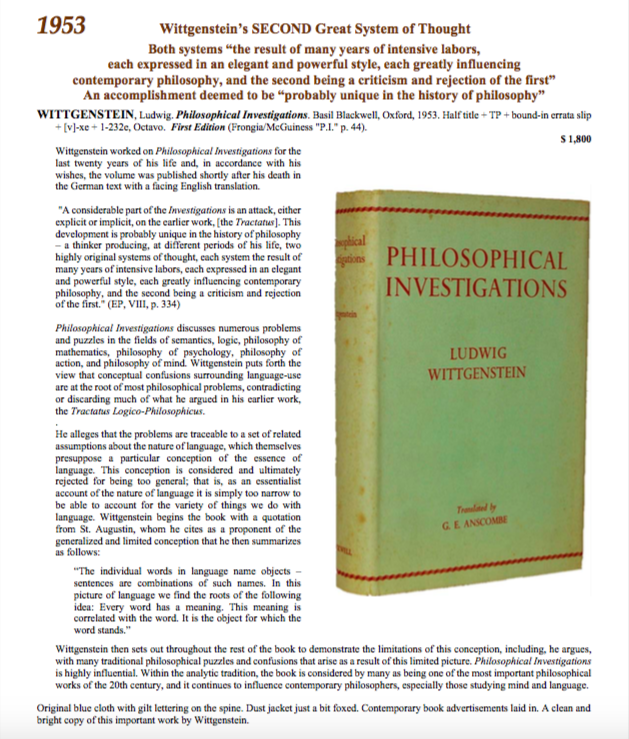
- Book Details
Original blue cloth with gilt lettering on the spine. Dust jacket just a bit foxed. Contemporary book advertisements laid in. A clean and bright copy of this important work by Wittgenstein.
William James' "The Varieties of Religious Experience"

William James (1842 -- 1910)
From Stanford Encyclopedia of Philosophy's entry on James:
- Intro & Enigmatic Ideas
William James was an original thinker in and between the disciplines of physiology, psychology and philosophy. His twelve-hundred page masterwork, The Principles of Psychology (1890), is a rich blend of physiology, psychology, philosophy, and personal reflection that has given us such ideas as “the stream of thought” and the baby’s impression of the world “as one great blooming, buzzing confusion” (PP 462). It contains seeds of pragmatism and phenomenology, and influenced generations of thinkers in Europe and America, including Edmund Husserl, Bertrand Russell, John Dewey, and Ludwig Wittgenstein. James studied at Harvard’s Lawrence Scientific School and the School of Medicine, but his writings were from the outset as much philosophical as scientific. “Some Remarks on Spencer’s Notion of Mind as Correspondence” (1878) and “The Sentiment of Rationality” (1879, 1882) presage his future pragmatism and pluralism, and contain the first statements of his view that philosophical theories are reflections of a philosopher’s temperament.
James hints at his religious concerns in his earliest essays and in The Principles, but they become more explicit in The Will to Believe and Other Essays in Popular Philosophy (1897), Human Immortality: Two Supposed Objections to the Doctrine (1898), The Varieties of Religious Experience (1902) and A Pluralistic Universe (1909). James oscillated between thinking that a “study in human nature” such as Varieties could contribute to a “Science of Religion” and the belief that religious experience involves an altogether supernatural domain, somehow inaccessible to science but accessible to the individual human subject.
From Athena's catalog:
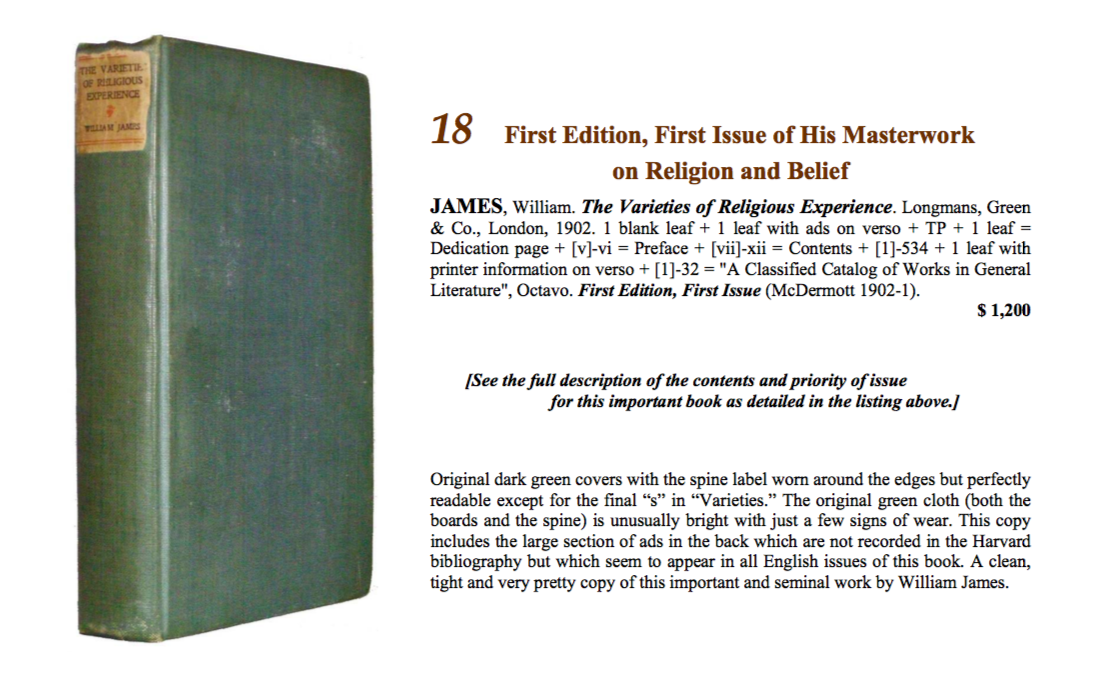
- Book Details
Original dark green covers with the spine label worn around the edges but perfectly readable except for the final “s” in “Varieties.” The original green cloth (both the boards and the spine) is unusually bright with just a few signs of wear. This copy includes the large section of ads in the back which are not recorded in the Harvard bibliography but which seem to appear in all English issues of this book. A clean, tight and very pretty copy of this important and seminal work by William James.
Carl Jung's "Modern Psychology Seminars"
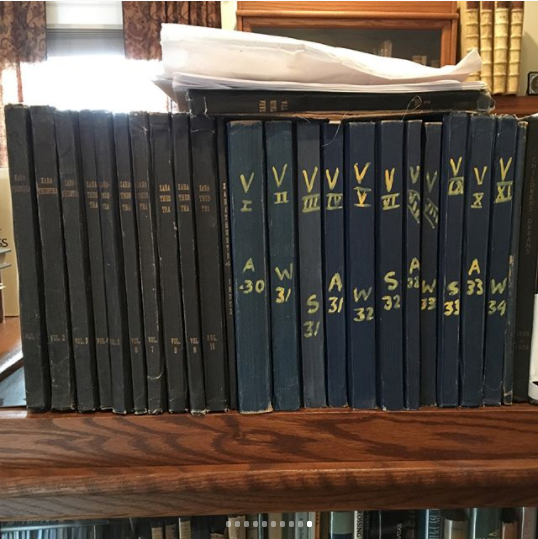
Carl Jung (1875 -- 1961)
From Encyclopedia Britannica entry on Jung:
- Intro
Carl Jung, in full Carl Gustav Jung, (born July 26, 1875, Kesswil, Switzerland—died June 6, 1961, Küsnacht), Swiss psychologist and psychiatrist who founded analytic psychology, in some aspects a response to Sigmund Freud’s psychoanalysis. Jung proposed and developed the concepts of the extraverted and the introverted personality, archetypes, and the collective unconscious. His work has been influential in psychiatry and in the study of religion, literature, and related fields.
- Enigmatic Ideas
Besides the development of new psychotherapeutic methods that derived from his own experience and the theories developed from them, Jung gave fresh importance to the so-called Hermetic tradition. He conceived that the Christian religion was part of a historic process necessary for the development of consciousness, and he also thought that the heretical movements, starting with Gnosticism and ending in alchemy, were manifestations of unconscious archetypal elements not adequately expressed in the mainstream forms of Christianity. He was particularly impressed with his finding that alchemical-like symbols could be found frequently in modern dreams and fantasies, and he thought that alchemists had constructed a kind of textbook of the collective unconscious. He expounded on this in 4 out of the 18 volumes that make up his Collected Works.
His historical studies aided him in pioneering the psychotherapy of the middle-aged and elderly, especially those who felt their lives had lost meaning. He helped them to appreciate the place of their lives in the sequence of history. Most of these patients had lost their religious belief; Jung found that if they could discover their own myth as expressed in dream and imagination they would become more complete personalities. He called this process individuation.
From Athena's catalog:
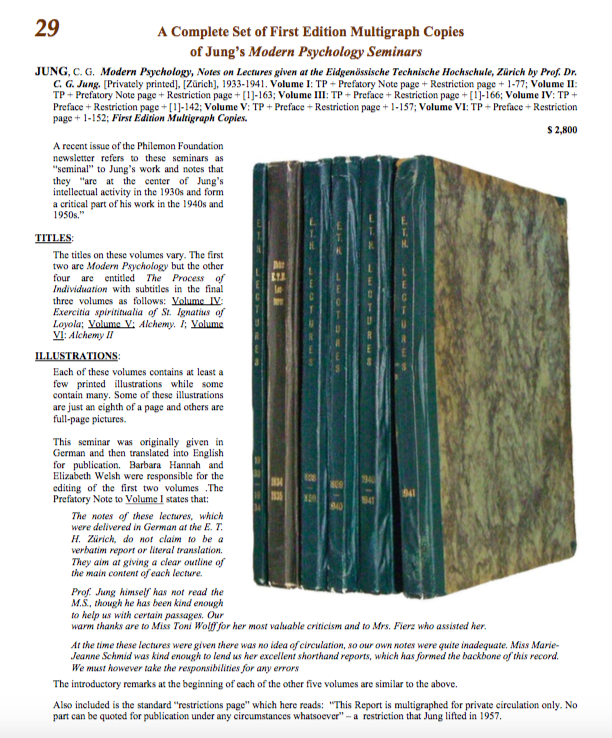
- Book Details
Each volume is an original Multigraph copy with the single-sided text bound using three large staples. The covers are mottle light green and black boards with green canvas on the spines (except for volume II which has black canvas [as issued]) with gilt lettering giving titles and the years in which the presentations were made. With the most minor of bumps to the exteriors of the first five volumes. Volume VI has suffered a bit of warping of both the covers and the text from humidity. Otherwise, this is a beautiful set of these first edition copies of this series of seminars.
Congratulations! This post has been upvoted from the communal account, @minnowsupport, by distillationsbl from the Minnow Support Project. It's a witness project run by aggroed, ausbitbank, teamsteem, theprophet0, someguy123, neoxian, followbtcnews, and netuoso. The goal is to help Steemit grow by supporting Minnows. Please find us at the Peace, Abundance, and Liberty Network (PALnet) Discord Channel. It's a completely public and open space to all members of the Steemit community who voluntarily choose to be there.
If you would like to delegate to the Minnow Support Project you can do so by clicking on the following links: 50SP, 100SP, 250SP, 500SP, 1000SP, 5000SP.
Be sure to leave at least 50SP undelegated on your account.
Congratulations @distillationsbl! You have completed some achievement on Steemit and have been rewarded with new badge(s) :
Click on any badge to view your own Board of Honor on SteemitBoard.
For more information about SteemitBoard, click here
If you no longer want to receive notifications, reply to this comment with the word
STOP@distillationsbl you were flagged by a worthless gang of trolls, so, I gave you an upvote to counteract it! Enjoy!!